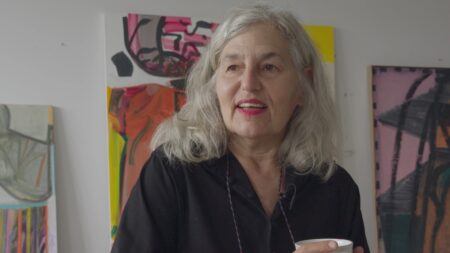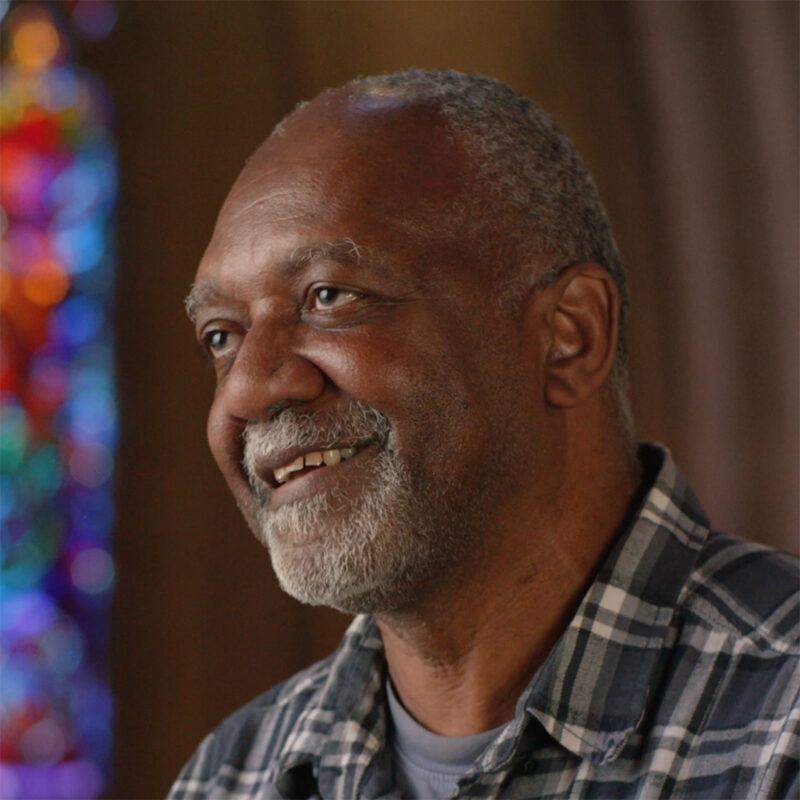Continue playing
(Time remaining: )
Play from beginning
Continue playing "{{ controller.videos[controller.getVideo(controller.currentVideo)].segmentParentTitle}}"
{{controller.videos[controller.getVideo(controller.currentVideo)].title}} has ended.
"Now and Forever"Kerry James Marshall
Amidst the grand architecture and intricate stained glass of the Washington National Cathedral, artist Kerry James Marshall stands before an audience gathered for the unveiling of his new work Now and Forever. The stained glass windows the artist designed were commissioned to replace the Robert E. Lee and Thomas “Stonewall” Jackson windows that were removed from the Cathedral in 2017. As Marshall addresses the crowd seated in the church pews, he reflects on his long career making images and the power of art to “invite us to imagine oneself as a subject and an author of a neverending story that is still yet to be told.” The story he chooses to tell in the Now and Forever windows is one of protest, calling back to the founding of the United States and the constitutional clause that allows for the redress of grievances and the continual revision and improvement of our nation through struggle.
The windows feature anonymous individuals marching and holding signs that state “Fairness Not No Foul Play” when read together. The statement is inspired by the words of Chicago’s first Black Mayor, Harold Washington, and draws a relationship between the ideal state of “fairness” and the “foul play” that disrupts that state and must be fought against. Throughout his life, Marshall has witnessed the struggles and injustices that condition the lives of many across the United States and the world, and it is these experiences that shaped the imagery that the artist conceived for Now and Forever and that inform his practice as a whole. For Marshall, the replacement of the windows represents a mandate. “The chance to live,” he says, “makes us obligated to do whatever we can to guarantee that those processes that were played out before we arrived are not repeated in the same way.”
More information and creditsCredits
Director: Ian Forster, Jurrell Lewis. Executive Producer: Tina Kukielski. Series Producer: Ian Forster. Editor: Kyle Turgeon. Archival Producer: Leah Ford. Camera: Daryl Pittman, Jane Macedo Yang. Assistant Camera: Kevin Marshall. Sound: Alan Brenner. Colorist: Kyle Turgeon. Sound Mix: Collin Blendell. Associate Producer: Andrea Chung. Assistant Curator: Jurrell Lewis. Assistant. Editor: Michelle Hanks. Music: Epidemic Sound, Adi Goldstein, Brock Hewitt, Yeti Music. Artwork Courtsy: Kerry James Marshall, Jack Shainman Gallery, Washington National Cathedral. Special Thanks: Kevin Eckstrom, Tamsen Greene, Andrew Goldkuhle, Rev. Leonard L. Hamlin Sr., Rev. Randolph Marshall Hollerath. Archival Material: “Chicago Politics: A Theater of Power Part II” Provided by Chicago Film Archives, John F. Kennedy Presidential Library & Museum, Los Angeles Fire Department Historical Society, Media Burn Archive, National Archives & Records Administration, Pond5, University of South Carolina MIRC. Walter J. Brown Media Archives, University of Georgia Libraries.
Extended Play is presented by the Marina Kellen French Foundation, with support from The Andy Warhol Foundation for the Visual Arts, public funds from the New York City Department of Cultural Affairs in partnership with the City Council, the New York State Council on the Arts with the support of the Office of the Governor and the New York State Legislature, the Henry Nias Foundation, and individual contributors. Producers: Barbara & Andrew Gundlach.
Closed captionsAvailable in English, German, Romanian, Italian, Japanese, Korean, Chinese, Italian
Through the Art21 Translation Project, multilingual audiences from around the globe can contribute translations, making Art21 films more accessible worldwide. Translate this video now.
Interested in showing this film in an exhibition or public screening? To license this video please visit Licensing & Reproduction.
The subject matter of Kerry James Marshall’s paintings, installations, and public projects is often drawn from African American popular culture, and is rooted in the geography of his upbringing. Marshall’s work is based on a broad range of art-historical references, from Renaissance painting to black folk art, from El Greco to Charles White. A striking aspect of Marshall’s paintings is the emphatically black skin tone of his figures—a development the artist says emerged from an investigation into the invisibility of Black people in America and the unnecessarily negative connotations associated with darkness. The sheer beauty of his work speaks to an art that is simultaneously formally rigorous and socially engaged.
“The chance to live makes us obligated to do whatever we can to guarantee that those processes that were played out before we arrived are not repeated in the same way.”
Kerry James Marshall

